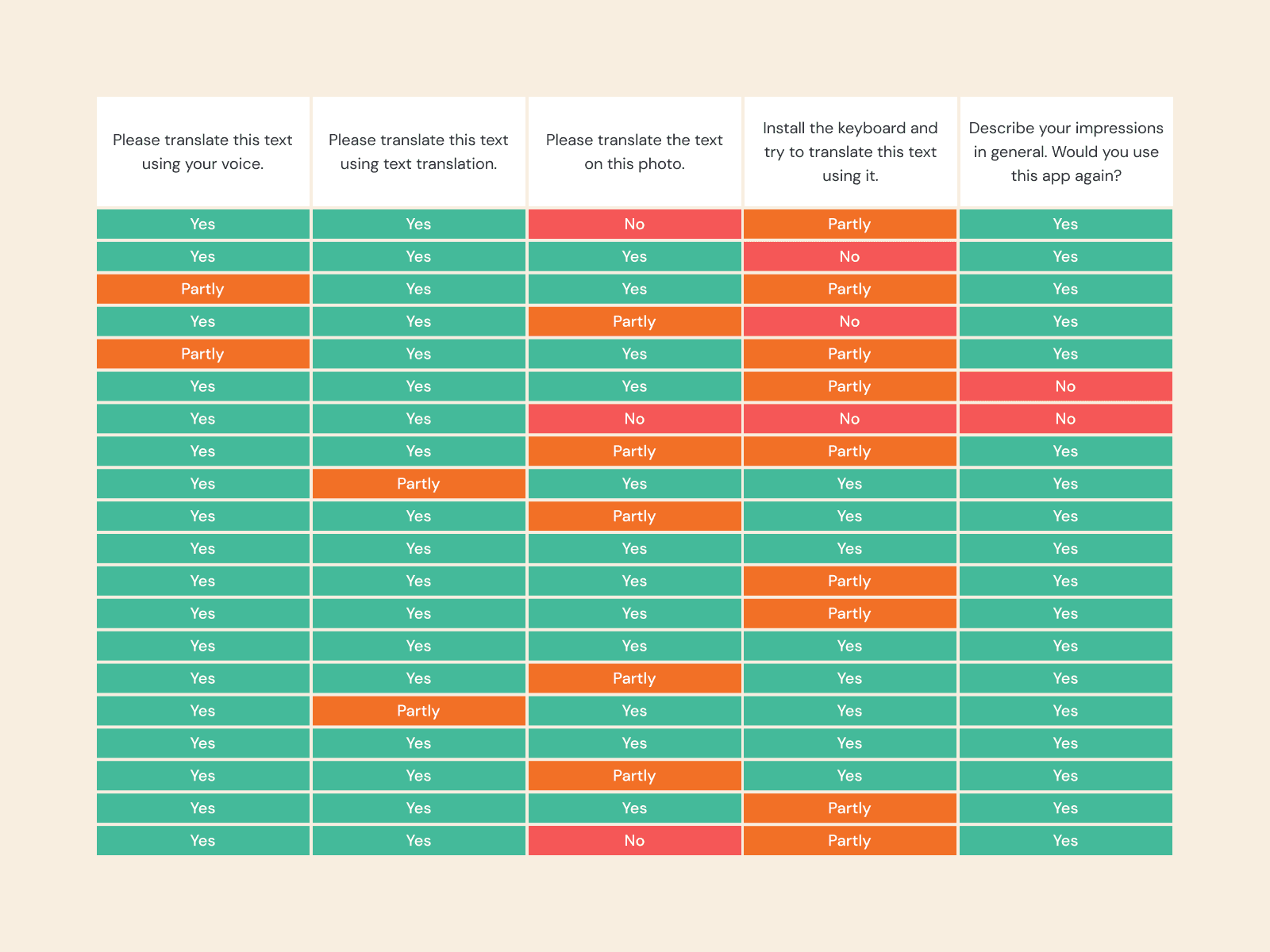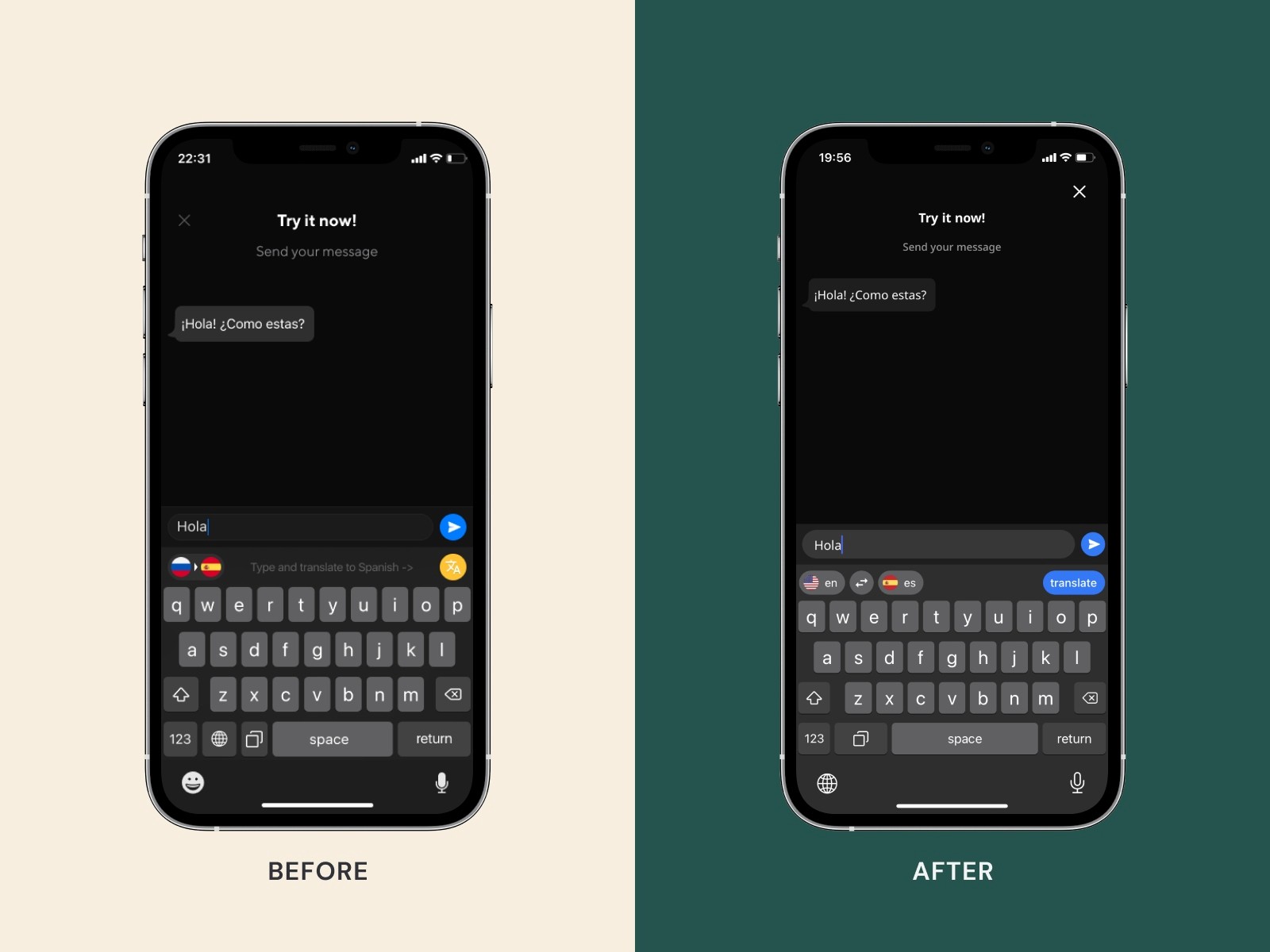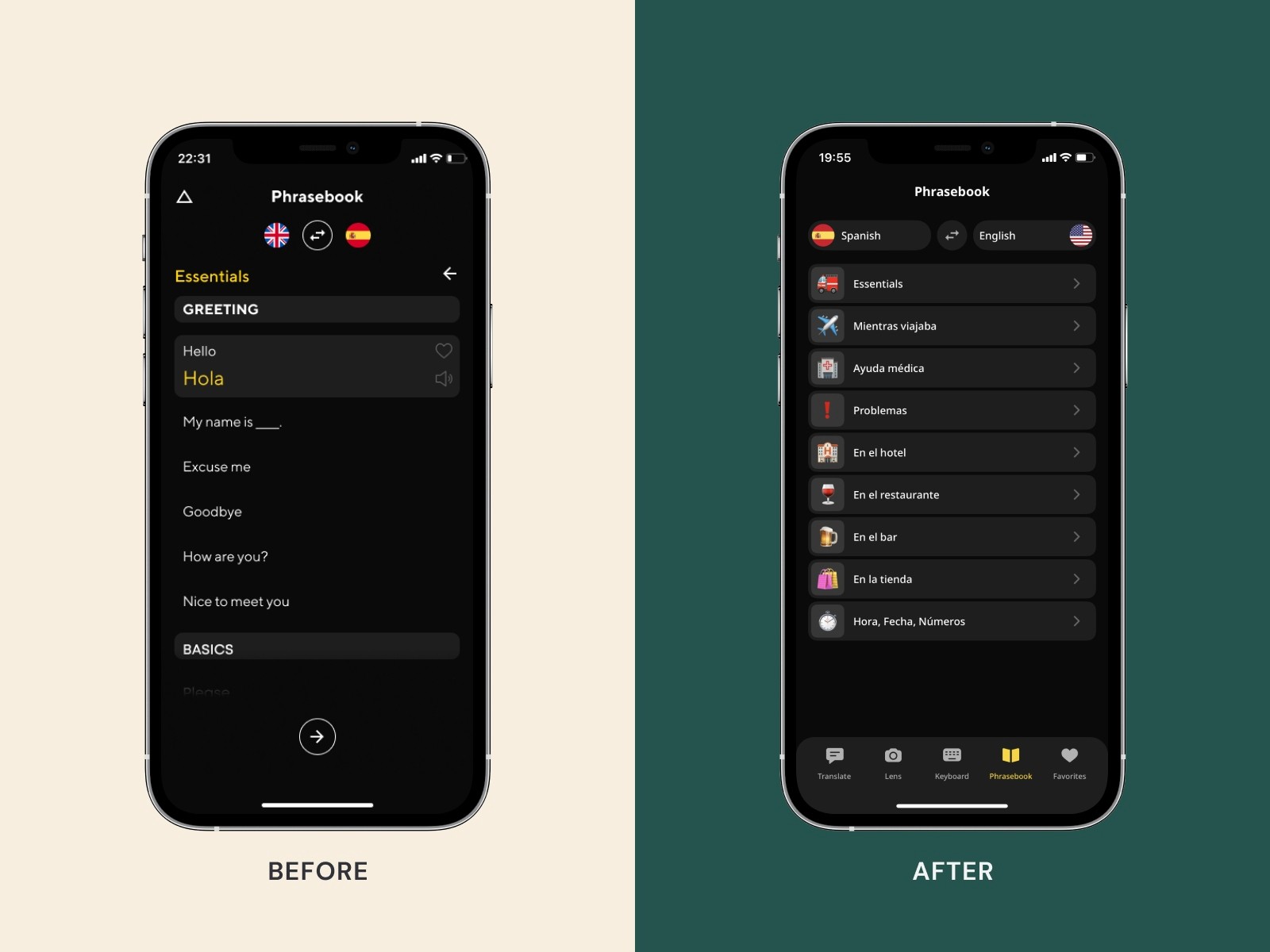Genesis Tech
Translator Guru
Summary: The translating app Translator Guru wasn't gaining enough paid subscribers. We researched the app's usability and found numerous problems with user flow. After we fixed these problems, the conversion rate increased by 20 percent in a month and a half.
What is Translator Guru
Translator Guru is an app that translates over 100 languages. The basic translator has voice, text, and keyboard translations. The premium features include unlimited translations and instant camera translation. Available on the AppStore.
Problem
The app was not profitable. Despite the number of downloads being relatively high, users did not use the app after enabling the free trial and did not pay for a premium service later.
My objective was to find a reason for this. I had to conduct research, generate hypotheses, test them, and then offer and implement a solution.
Research
Translator Guru has many competitors; all of them work similarly. However, the competitors seem to have no difficulties with monetization (according to Sensor Tower). So the Translator Guru's product owner had a hypothesis that users are merely uncomfortable with the app. And since they see no value in the product, there is no point in buying the premium version. To understand user behaviour in the app, I conducted a series of interviews. When choosing the respondents, I focused on the same category of users that Translator Guru targeted with Facebook ads: 25-35 years old, 70 percent of men and 30 percent of women. We were interested not only in Translator Guru users but also in people who use translation apps.
There were 20 interviews in total. First, testers translated the given text in different forms: using voice, text, camera, and the built-in keyboard. Then they shared their impressions of the app. I entered the interview transcripts into a colour-coded table displaying the success of each use for a specific task. It helped us notice the app's problematic features and the number of people who encountered difficulties using them.

Moderated testing showed that the application is nonviable in its current form: users got lost in the interface and had to perform too many actions to get a translation. Most of the problems arose with camera translation and the built-in keyboard: Half the respondents did not understand how to use these features. However, integrating a keyboard translator into the phone was viewed as a positive feature.
Many interviewees complained that they didn't trust the quality of the translation. However, the reason for such an impression was not the poor translation mechanism but the current user flow that could not solve the users' problems.
I would like the keyboard to be somehow different from the standard IOS one because I didn't understand at all that this is a separate keyboard.
I expected the keyboard to translate the text right away. I pressed the yellow button with an undefined symbol and got the translation. Intuitively I expected that I would enter the text and get it translated right away, but it turns out I still need to take another step.
Why do I need a camera function if I can't translate right away? I once used such a thing, and it translated immediately, but here I got nothing.
What's the difference between text translation and keyboard translation?
I'd use a keyboard if it completely duplicated the functions of a standard keyboard and had a translator at the same time. I wouldn't sacrifice the convenience of typing, although I'm quite interested in translating with the keyboard.
Research continued
After testing, we thought: maybe the number of users we interviewed at the beginning was not enough. All interview participants were from Russian-speaking regions. What if audiences from other countries behave differently?
To double-check our hypotheses, I did another series of interviews, this time with people from the US and Europe. We found the participants on the User Testing platform.
As a result, all our hypotheses were confirmed! Users from the US and Europe experienced the same difficulties in the app as Ukrainians. Thus, we realized that Translator Guru needed a redesign.
Solution
The interviews helped us identify user issues and understand which problems cause the most difficulties in using the app. Then, we solved these problems with a new design.
Main screen

Before:
Text translation and keyboard icons were situated side by side, and users confused them;
Language selection was located under the translation button. The languages were indicated only by a flag icon, so users didn't understand which language they selected;
If there were mistakes in an original text, it couldn't be edited after translation. Users had to go back and type it again.
After:
Text translation is now available directly from the main screen. The voice translation button is highlighted in colour. The camera and keyboard icons are now placed at the bottom;
Language selection was moved to the top since it is used less often than the translation button. The language is now indicated with its name, as well as with the flag;
The original text can now be edited.
Language selection

Before:
Users had to scroll through the list each time to select a language or use search;
Users had to choose original and translation languages on two different screens.
After:
Frequently used languages are shown at the top of the list now;
Language choice is now available using one picker.
Keyboard

Before:
The translation button had no copy, so people didn't understand what they should do to get a translation. The button was yellow, which made it hard to see it in the iOS light mode;
To switch languages, users had to go to the menu containing all languages;
The languages were indicated only by a flag icon, so users didn't understand which language they selected.
After:
We added the button copy and painted the button in blue colour, standard for iOS;
We added the language switch button;
The language is now displayed with its name, as well as with the flag.
Voice translation

Before:
Users didn't understand they had to click on the button to complete the translation;
The translation was displayed on full screen. After that, users could only go to the main screen. It was unclear how to translate once again or edit the original text;
The last translation was displayed on the main screen, but it couldn't be copied or listened to.
After:
Now, users need to hold down the button, say the phrase, and then release the button. This mechanic is used in messengers, so it's more familiar to users;
We removed the intermediate screen with translation. Now the text is displayed directly on the main screen. Users can also edit the original text there if necessary;
The last translation on the main screen can now be copied, listened to, or shared.
Camera

Before:
Users didn't understand how to use a camera for translating;
Users tend to forget which languages they chose initially;
Users couldn't copy the whole scanned text from the photo;
Sometimes, it was unclear how to switch between translation areas;
Users didn't always understand that it's possible to enlarge a photo after scanning;
Users expected to see the entire translation after clicking the OK button or the copy history. Instead, they were offered to scan the photo again.
After:
The camera translation is moved to the tab bar on the main screen;
Now, users can see original and translation languages on the translation screen. The original language is highlighted in yellow;
We added the ability to collect parts of scanned text and copy them altogether;
The translation areas are highlighted in blue instead of purple, so they are more contrasting now;
We enlarged the scanned area of the photo, so it's clear now how to interact with the interface;
The scanning flow changed completely. After scanning, users now get to a new screen to select the text for translation, change the language, save, or copy the results. Also, we got rid of the OK button.
Favourites, History, and Phrasebook

Before:
Users didn't understand the navigation on these screens. For example, they opened the phrasebook and couldn't close it;
There was no way to copy the translation from history and favourites.
After:
We added a tab bar with independent tabs to the main screen. Also, we applied the iOS native navigation throughout the app;
Now, users can copy, share, or listen to translations from history and favourites.
We had a month and a half to complete the redesign. We involved the app developer at all stages to speed up the process. We sketched out 5-6 options for UX solutions, and the developer commented on which ones were easier to implement. In this way, we didn't waste time refining too expensive ideas.
The development took a month. However, the result was quick because the developer was already aware of our ideas. Dividing the release into two parts has also pushed the process forward: first, we released an update for text and voice translation, and over time, we improved the camera translation.
Result
A month and a half after the release, the conversion rate increased by 20 percent and continues to grow!